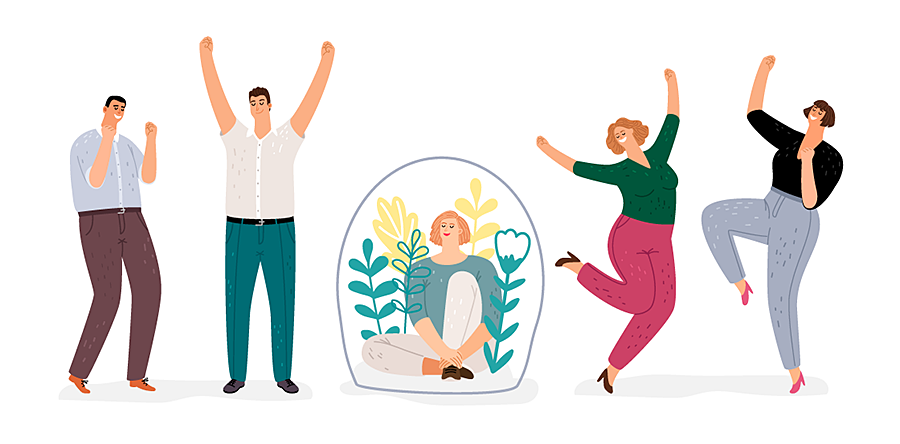Many leaders have found that remote work has not hampered their operations, and, in fact, has brought some benefits to the business. And with two years under our belts, many employees are beginning to adapt and prefer this new way of working.
In December last year, Ipsos surveyed 1,001 working Canadians over 18 about their experience in 2021 and outlook for 2022. Only half of the respondents working from home said they expect to return to the office this year.
However, the same survey revealed that 58% of respondents miss being with their colleagues. And a CAMH survey earlier this year revealed a spike in loneliness, up to 24% from 19% in the summer of 2021.
Loneliness and isolation can lead to increased stress and mental illness
Many people lack the skills and confidence to foster connections on their own even when working in the same space as colleagues, and for those working remotely, the challenge becomes much greater.
When people don’t know how to develop valued, authentic connections in the workplace, it can lead to feelings of isolation and loneliness, which can develop into more serious, longer-term issues. Though isolation and loneliness aren’t mental illnesses, they can increase stress levels, leading to depression and anxiety.
Nobel prize winners Daniel Kahneman and Angus Deaton found that feeling alone was one reason a worker would not experience positive emotions such as enjoyment and happiness. This emotional state correlates with a high incidence of negative emotions such as stress, worry, and sadness.
And it doesn’t take long to feel this way. The Lancet reported that among “the workers assigned periods of perceived isolation,” long-term effects can result in fewer than ten days and can experience psychiatric symptoms up to three years later.
The business case for paying attention to wellbeing and connectedness
There are many other reasons to stay on top of personal psychological safety and connectedness. Healthy workplace relationships translate into higher levels of productivity and engagement, and when employees feel a sense of belonging and inclusion, they are less likely to experience mental strain and take disability leave.
- On average, mental health issues account for 30%-40% of short-term disability claims
- In May 2021, The Canadian Pension and Benefits Institute reported that short-term disability claims due to mental health issues increased 6%, and duration was up by 12%.
- In 2020, when workers were still adjusting to lockdowns and remote work, claims for mental health supports increased by 24%, according to data from Canadian Life and Health Insurance Association members.
It isn’t easy to admit to feelings of loneliness, especially if people are aware that many of their colleagues are adapting to new working arrangements without difficulty. Stigma can prevent help-seeking behaviours like asking a direct leader for support to feel more connected.
Bust stigma and help employees stay connected
With more employees working remotely and nearly half (as reported by both Ipsos and World Economic Forum) feeling isolated and lonely. These protective steps will help you mitigate the impact of isolation and loneliness and increase the likelihood that employees will reach out for help.
- Start by asking three critical questions:
- What percentage of our employees, remote and onsite, are experiencing feelings of isolation and loneliness?
- What are we doing to reduce the risk of workers experiencing these feelings?
- How do we know what we are doing is working, and how are we measuring success?
- Make a mental fitness plan for yourself and encourage employees to do the same. This doesn’t have to be an onerous task, even creating a checklist of actions to counteract unpleasant emotions can help shift your mindset and generate positive emotions.
- Prepare leaders to support remote workers. This Harvard Business Review article outlines the benefits of providing training and skills development to help organizational leaders and remote employees build and maintain psychologically safe human connections.
- Invest time supporting remote workers and encourage other leaders to do the same. Howatt HR recently published a white paper, Being a psychological safe leader in the new world of work, a guide to help leaders support remote workers. Key actions include regularly checking in on employees, monitoring the wellbeing of direct reports, and being careful not to assume that no news is good news.
- Offer digital solutions – There are many digital tools and resources available that can help relieve feelings of loneliness and isolation, including meditation and fitness apps and videos. The Hugr Authentic Connections app created by WSPS, HowattHR, and Territorial leads users on a journey to help alleviate isolation and loneliness using self-assessments, content, and monitoring tools. There is even an opportunity to share personal experiences and thoughts with a trusted connection. It is available through Apple and Google.
- Ensure that you and other leaders regularly assess. Take pulse checks, conduct listening tours and workplace mental health assessments, and pay attention to insights and data.
- Do not assume workers know how to avoid feeling lonely and isolated. Skills that promote behavioural health and support emotional wellbeing can be learned. Provide workers with training on isolation, stigma, signs and symptoms of loneliness and isolation, and mental fitness (e.g., developing and maintaining authentic connections in the workplace). Employees who improve their psychological resilience by just 5% decrease their risk of mental illness by 10%-15%.
Whether employees work onsite, remotely or you operate in a hybrid manner, the way we interact and connect with one another has changed forever. The issue of isolation isn’t a new one, but it has become more acute for some who are having difficulty adjusting to this new reality. It is important that you and other leaders in your organization accept this and plan for it. Your efforts to connect people and to help them feel a sense of belonging can help prevent unnecessary mental health issues and will go a long way toward employee engagement and retention and business success.
Get to know the author – Dr. Bill Howatt

 Dr. Bill Howatt
Dr. Bill Howatt



